Learning how to swing a golf club effectively is essential for improving your game and unleashing your potential in golf. By focusing on proper technique, mechanics, and the fundamentals of the golf swing, you can enhance your performance on the course. In this article, we will explore the step-by-step process of swinging a golf club, including foot placement, grip, alignment, posture, backswing, downswing, and follow through. By following these guidelines, you can develop a more consistent and powerful golf swing.
Key Takeaways:
- Mastering the golf swing is crucial for improving your game and maximizing your potential on the course.
- Proper foot placement and alignment are the first steps to achieving an effective golf swing.
- A correct grip and hand placement are crucial for a successful golf swing.
- Maintaining proper posture and stance is essential for balance and power in your swing.
- The backswing, downswing, and follow through are key components of a functional golf swing.
Start with Proper Foot Placement and Alignment
In order to swing a golf club effectively, it is crucial to start with proper foot placement and alignment. By ensuring that your feet are in the correct position, you can set yourself up for success and improve your overall swing.
First and foremost, position your feet shoulder-width apart, providing a stable base for your swing. Your front foot should be slightly ahead of the ball, allowing for optimal weight transfer during the swing. This placement helps to promote a smooth and controlled swing motion.
Next, it is important to align your feet and shoulders towards your target. Imagine an imaginary line passing from your back shoulder to your front shoulder and from your back foot to your front foot, pointing directly at the target or the hole. This alignment ensures that your swing is directed towards your desired target, increasing the accuracy of your shots.
Additionally, the position of the golf ball is crucial for proper foot placement and alignment. Place the golf ball towards the middle of your stance, ensuring that it is in line with your front foot. This positioning allows for optimal contact and control during the swing.
“Proper foot placement and alignment are the foundation of a successful golf swing. By positioning your feet correctly and aligning towards your target, you set yourself up for a more accurate and effective swing.”
By focusing on proper foot placement, alignment, and golf ball position, you can establish a strong foundation for your swing. This will help you achieve better balance, stability, and control throughout your swing, resulting in more consistent and accurate shots on the golf course.
Grip it Right: Mastering the Proper Golf Grip
When it comes to swinging a golf club effectively, one of the most important aspects to master is the proper golf grip. The way you hold the club can greatly influence the outcome of your swing and the trajectory of the ball.
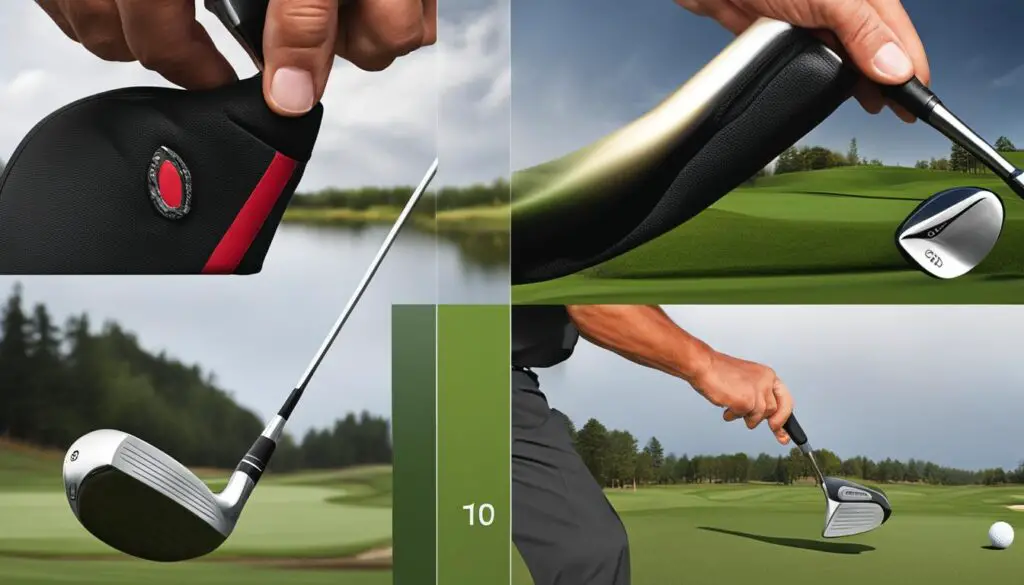
Having a correct grip allows for better control, power, and consistency in your swing. Here are some key points to keep in mind:
- Hand Placement: Position your hands on the club, allowing the grip to rest in your fingers rather than the palm of your hand. This ensures a lighter grip and better wrist action during the swing.
- Grip Strength: Find a balance between a grip that is too tight and one that is too loose. Hold the club firmly, but avoid excessive tension that can restrict your swing.
- Finger Position: The placement of your fingers on the club is crucial. Ensure that your fingers are wrapped around the grip securely, with the pad of your thumb resting on top of the club.
Experiment with different grip options, such as the baseball grip, overlap grip, and interlocking grip, to find the one that feels most comfortable and natural for you. Remember, a proper grip sets the foundation for a successful swing and can greatly improve your overall performance on the course.
Maintain Proper Posture and Stance
To achieve a consistent and powerful golf swing, it is crucial to maintain proper posture and stance. Your golf posture sets the foundation for a balanced and efficient swing, while your spine angle, shoulder alignment, and knee flexion contribute to the overall mechanics of your swing.
When addressing the ball, stand with your feet shoulder-width apart and your weight evenly distributed between them. Bend at the waist, ensuring your back remains fairly straight. This posture allows you to reach the ball comfortably and generate power from your core.
Check your spine angle by placing a club against your back. The club should touch your head, between your shoulder blades, and your tailbone. This alignment helps ensure a proper swing plane and consistent ball striking. Additionally, align your shoulders parallel to the target line and slightly tilt them away from the target, allowing for a full rotation during the swing.
Lastly, maintain a slight flex in your knees throughout the swing. This flexion allows for stability and proper weight transfer during the swing. Remember, your posture and stance are the building blocks of a successful golf swing, so pay attention to these fundamentals for improved performance on the course.
Key Takeaways:
- Stand with feet shoulder-width apart and weight evenly distributed.
- Bend at the waist with a fairly straight back.
- Check spine angle using a club against your back.
- Align shoulders parallel to the target line.
- Maintain a slight flex in your knees throughout the swing.
Execute a Controlled Backswing
The backswing is a crucial part of the golf swing that sets the foundation for a powerful and accurate shot. It involves positioning the club and rotating the body to generate momentum and prepare for a controlled downswing. To execute a controlled backswing, follow these steps:
- Start by moving your hands straight back while keeping them close to your back leg. This movement helps maintain the correct club position and prevents the club from getting too far away from your body.
- As you continue the backswing, allow the club head to hinge backward, with the shaft becoming almost parallel to the ground. This position ensures proper club positioning and sets the stage for generating power.
- Focus on a slight wrist break and a shoulder turn to rotate your torso around your spine. This rotation helps create torque and builds up energy for the downswing.
- During the backswing, pay attention to your wrist action. Maintain proper wrist angle and avoid excessive wrist movement, as this can lead to inconsistency and less control over the clubface.
By executing a controlled backswing, you lay the groundwork for a powerful and accurate shot. It enables you to generate the necessary momentum and set the stage for a well-coordinated downswing. Practice this phase of the swing to develop consistency and improve your overall golf game.
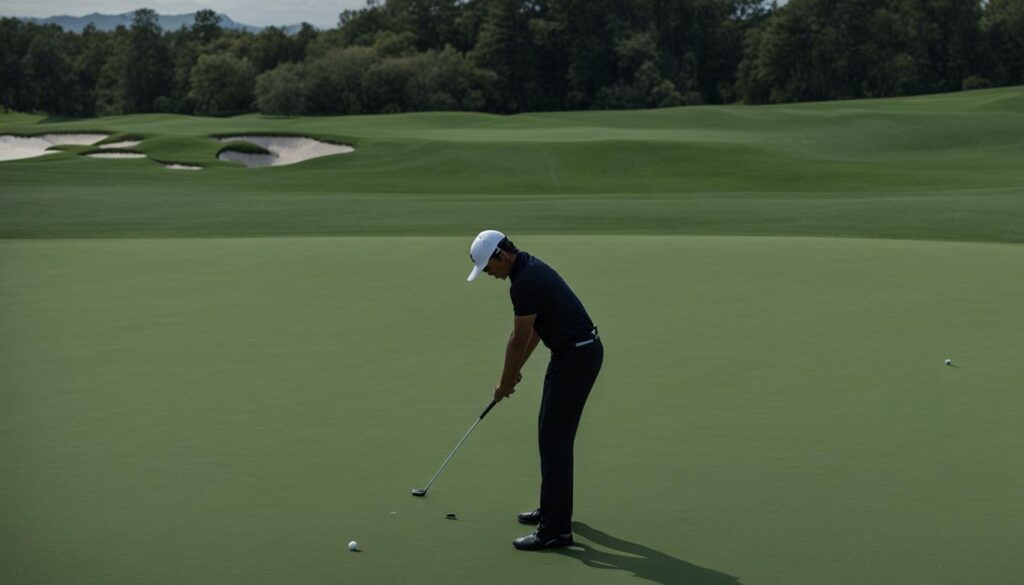
Perfecting the Backswing:
“The backswing is a critical part of the golf swing. It’s crucial to maintain a connection between your arms and body throughout the backswing. This connection allows for better control and power transfer during the downswing. Focus on maintaining a smooth and gradual rotation of the torso, keeping your arms and hands in sync with your body’s movement. This synchronization will help optimize club positioning and generate maximum power. Remember to stay balanced and maintain a relaxed grip during the backswing, as tension can hinder your swing mechanics.”
— Golf Pro, Jane Smith
Master the Downswing and Impact
Once you have executed a controlled backswing, the next crucial phase of the golf swing is the downswing and impact. This is where the power of your swing is unleashed, propelling the ball towards its target. To master the downswing and achieve optimal impact, focus on the following key elements:
- Weight transfer: Begin the downswing by shifting your weight from the ball of your back foot to the ball of your front foot. This weight transfer allows for a smooth transition and generates power as you move towards the ball.
- Club position: As you initiate the downswing, ensure that your club shaft is lagging behind your hands, creating a whipping motion. This delayed club release maximizes your clubhead speed and generates increased distance.
- Wrist release: Keep your wrists firm and your front arm straight until impact. At the precise moment of impact, release your wrists, allowing the clubhead to strike the ball with a forward-leaning club shaft. This produces a controlled and accurate shot.
Throughout the downswing and at impact, maintain the rotation of your hips and torso, driving through the ball with power and precision. Transfer your weight fully to your front foot, ensuring a balanced and controlled finish. Practice these downswing techniques to improve your swing rhythm and consistency, ultimately leading to better ball-striking and increased performance on the course.
Finish with Balance and Follow Through
After making contact with the ball, it’s essential to maintain balance and execute a proper follow through. This will not only improve your overall swing technique but also enhance your accuracy and distance. Here are some key aspects to focus on:
- Maintain a balanced body position: As you swing through the ball, strive to stay balanced and avoid leaning too far in any direction. Keep your weight centered over your feet, with slightly more weight on your front foot at the finish.
- Complete your body rotation: Allow your body to naturally rotate through the swing, following the direction of your club. This full rotation helps to generate power and contributes to a smooth follow through.
- Keep your head down: It’s important to resist the urge to lift your head too soon after striking the ball. Keep your eyes focused on the ball until it’s well on its way to the target, maintaining proper head position throughout the swing.
The follow through is a reflection of the swing that preceded it. By practicing a balanced and controlled finish, you’ll develop muscle memory and consistency in your swing. Remember, the follow through is not just a formality—it’s an integral part of the swing that can greatly influence the outcome of your shots.
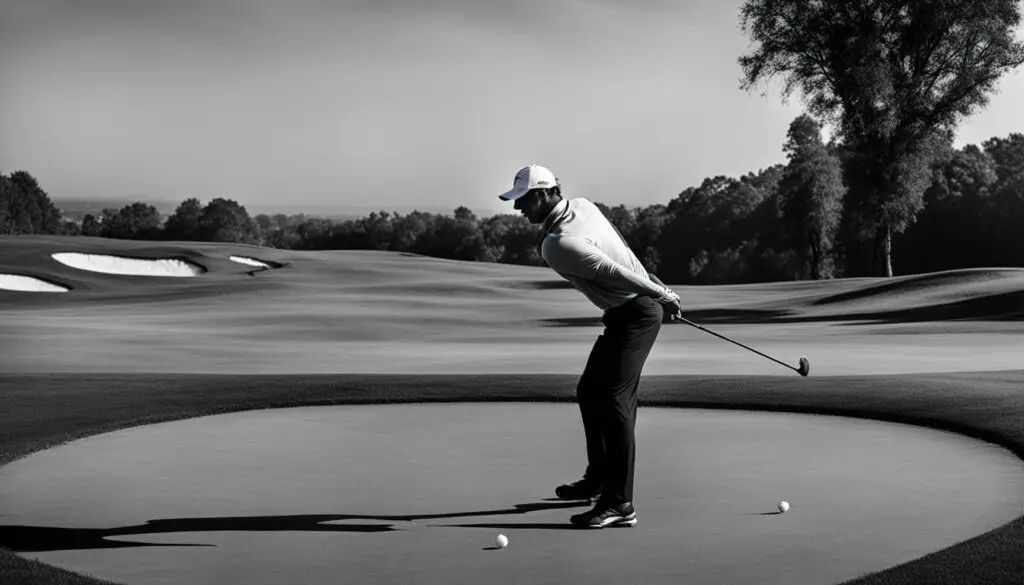
A Quote to Inspire
“The follow through tells you everything, really. If the follow through is smooth and balanced, then the swing was good. If you’re falling all over yourself, you know you’ve missed it somehow.” – Tiger Woods
Correcting the Slice
One common issue that many golfers face is the slice, where the ball curves from left to right (for right-handed players). Fortunately, there are several adjustments you can make to correct this frustrating shot. One important adjustment is to focus on maintaining a slight knee bend throughout your swing. This helps promote a more inside-out swing path, which can reduce the likelihood of slicing the ball.
Another adjustment to consider is making changes to your grip. A weak grip can contribute to a slice, so experiment with strengthening your grip and rotating your hands slightly to the right (for right-handed players). By making these grip adjustments, you can encourage a more square clubface at impact and reduce the amount of sidespin on the ball.
Remember, correcting a slice takes time and practice. Be patient with yourself as you make these adjustments and focus on maintaining proper knee bend and grip. With persistence, you’ll start to see improvements in your ball flight and reduce those unwanted slices.
Learn from a Pro with RotarySwing
When it comes to mastering the art of swinging a golf club, it’s always beneficial to have guidance from a professional. That’s where RotarySwing comes in. RotarySwing offers a comprehensive golf swing system and instructional method that focuses on injury prevention, power, and efficiency. With a panel of renowned medical experts and instructors, RotarySwing prioritizes the development of a repeatable and effective golf swing.
RotarySwing’s golf instruction is designed to help golfers of all levels improve their swing mechanics and take their game to the next level. Whether you’re a beginner looking to build a solid foundation or an experienced golfer aiming for consistent improvement, RotarySwing has you covered. The structured approach and step-by-step guidance offered by RotarySwing make it easier to understand and implement the intricacies of a proper golf swing.
One of the key benefits of utilizing a golf swing system like RotarySwing is injury prevention. By focusing on proper mechanics and body movements, RotarySwing helps golfers avoid common swing-related injuries. The emphasis on injury prevention ensures that golfers can enjoy the game for years to come while minimizing the risk of developing chronic or acute golf-related injuries.
So, whether you’re a beginner looking to learn the fundamentals or an experienced golfer seeking to fine-tune your swing, RotarySwing’s golf instruction and swing method can be a game-changer. Embrace the structured approach, follow the step-by-step guidance, and watch your swing mechanics improve. With RotarySwing, you’ll be well on your way to becoming a more consistent, powerful, and efficient golfer.
Golf Swing Basics for Beginners
For beginner golfers, mastering the basics of the golf swing is crucial for building a solid foundation and setting yourself up for success on the course. The pre-swing set-up is where it all begins, and there are three key elements to focus on: grip, aim, and stance.
First, let’s talk about the grip. It’s important to hold the club with a light and relaxed grip, allowing for flexibility and control. Place the club in the fingers of your lead hand, with the “V” formed by your thumb and index finger pointing towards your trailing shoulder. With your trail hand, interlock your pinky finger with the index finger of your lead hand or place it snugly against your lead hand’s knuckles.
Next, aim your clubface towards your target. Align it parallel to your target line, which is an imaginary line that runs from the ball to your target. This will help ensure that your shots go in the intended direction. Lastly, adopt a shoulder-width stance with a little knee bend. Your weight should be evenly distributed between both feet, and your posture should be upright and comfortable.
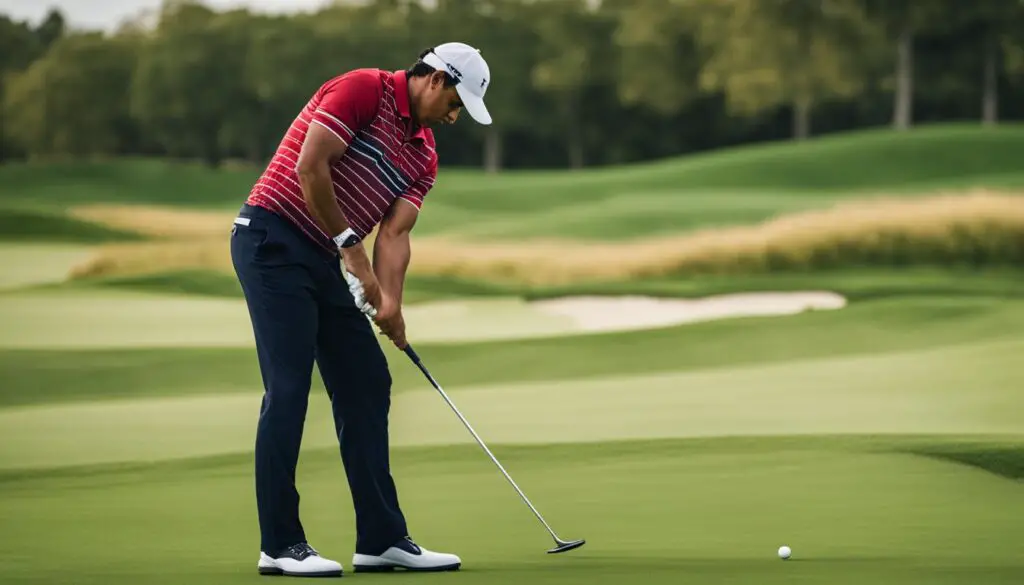
By focusing on these golf swing basics, beginner golfers can establish a strong foundation for their game. Practicing the pre-swing set-up, grip, aim, and stance will help develop consistency and control, setting the stage for further improvement as you progress in your golf journey.
Mastering the Backswing
When it comes to mastering your golf swing, the backswing is a crucial element that sets the stage for a powerful and accurate shot. It’s important to focus on proper backswing technique, including rotation, wrist position, and shoulder turn. By understanding and implementing these key elements, you can improve your swing consistency and overall performance on the course.
Rotation is a fundamental aspect of the backswing. As you initiate the backswing, rotate your torso around your spine, allowing your shoulders to turn and creating a coil-like effect. This rotation generates power and helps you store energy to be unleashed during the downswing. It’s essential to maintain a smooth and controlled rotation, avoiding any excessive movements that can lead to inconsistency and loss of power.
The position of your wrists during the backswing is another critical factor. Keep your lead wrist flat, maintaining a straight line from your forearm to the back of your hand. This position promotes a proper clubface alignment and prevents the club from getting too open or closed. As you continue the backswing, allow your trail wrist to hinge naturally, creating a 90-degree angle between your lead forearm and the shaft of the club.
Lastly, focus on achieving a solid shoulder turn during the backswing. Your lead shoulder should rotate underneath your chin, while your trail shoulder moves behind your head. This full shoulder turn maximizes your torque and generates power for a more explosive downswing. By practicing and refining your backswing technique, you can develop a more consistent and effective golf swing.
Benefits of a Proper Backswing
- More power and distance: A correct backswing technique allows you to generate more power, resulting in longer shots off the tee and improved distance on your irons.
- Better accuracy and ball-striking: When your backswing is on point, it sets the foundation for a more accurate and consistent downswing, leading to better ball-striking and improved shot dispersion.
- Reduced risk of injury: By focusing on proper rotation and maintaining a neutral wrist position during the backswing, you can minimize the risk of strain or injury to your body.
“The backswing is like winding up a spring. Your goal is to create as much potential energy as possible, which can be released during the downswing for maximum clubhead speed and accuracy.”
Executing the Downswing and Finish
After a controlled backswing, the downswing is where the power and precision of your golf swing come together. It’s crucial to execute the downswing and follow through correctly to achieve optimal impact and maximize distance. Here’s a breakdown of the key elements:
- Downswing Sequence: The downswing should start with a smooth weight transfer from your back foot to your front foot. As you shift your weight, rotate your hips and torso, generating rotational speed and power.
- Weight Transfer: Shifting your weight to your front foot during the downswing helps to move your body and club in sync, creating a powerful and well-coordinated swing. This transfer of weight enhances clubhead speed and control.
- Impact Position: As you approach impact, maintain a firm and controlled wrist position to ensure a consistent strike. The club shaft should be leaning slightly forward, allowing you to compress the ball properly. This impact position promotes accuracy and distance.
- Follow Through: A balanced and complete follow-through is essential for a well-executed swing. After striking the ball, continue your swing motion, allowing your body to rotate fully towards the target. Maintain your balance and hold your finish position until the ball has been hit.
Mastering the downswing and finish requires practice and attention to detail. Focus on the sequencing, weight transfer, impact position, and follow-through to enhance the power, accuracy, and consistency of your golf swing.
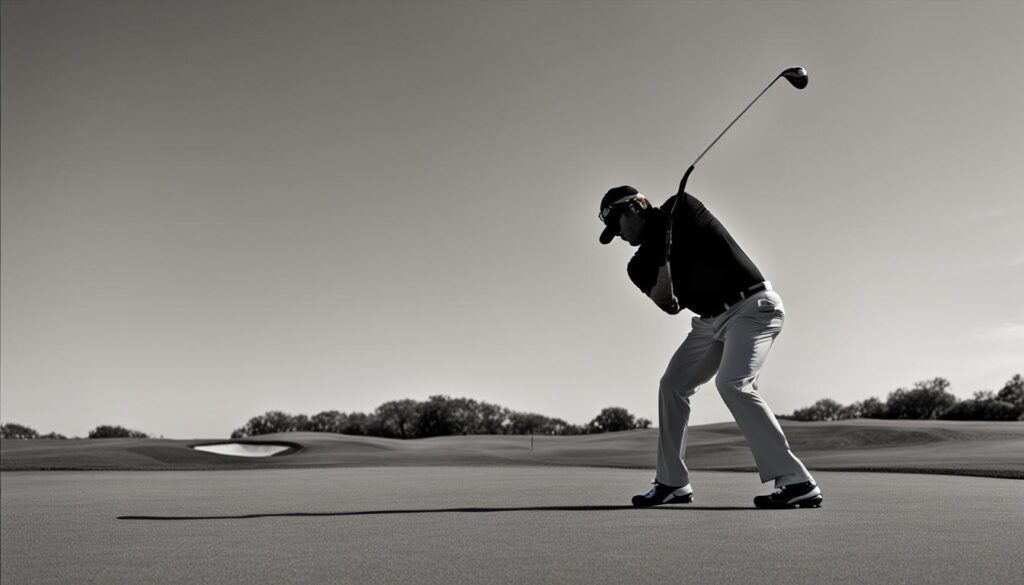
Fixing Common Swing Errors
Even the most experienced golfers can fall victim to common swing errors that can negatively impact their shots. Two of the most prevalent errors are slices and hooks, which result in shots that curve off target. Fortunately, there are strategies and adjustments that can be made to correct these issues and improve overall swing performance.
Common Swing Errors: Slices
Slices occur when the ball curves from left to right (for right-handed golfers) or right to left (for left-handed golfers). To correct a slice, focus on a few key areas:
- Adjust your knee bend: Maintain a slight knee bend throughout your swing to promote a more inside-out swing path.
- Make grip adjustments: Experiment with adjusting your grip, moving towards a slightly stronger grip to help reduce the slice.
Common Swing Errors: Hooks
Hooks, on the other hand, result in shots that curve from right to left (for right-handed golfers) or left to right (for left-handed golfers). To correct a hook, consider the following:
- Modify your grip: If you tend to hook the ball, try adjusting your grip to a slightly weaker position to help reduce the hooking action.
- Seek professional guidance: Consulting with a golf instructor can provide valuable insights and personalized guidance on correcting a hook and improving overall swing technique.
By addressing these common swing errors and implementing the necessary adjustments, golfers can achieve more accurate and consistent shots. It’s important to remember that correcting swing errors takes practice and patience. Working with a golf coach or using instructional resources can further enhance your understanding of the swing mechanics and help you develop a more reliable and effective golf swing.

Benefits of a Golf Swing System
Adopting a golf swing system, such as RotarySwing, offers several benefits for golfers of all levels. By following a structured approach, you can develop a repeatable and efficient swing motion that leads to improved performance on the course.
A golf swing system provides step-by-step guidance, focusing on proper mechanics and injury prevention. It offers a comprehensive method for learning and refining your swing, ensuring that you develop a solid foundation and build upon it with each practice session.
One of the main advantages of a golf swing system is its emphasis on injury prevention. By learning and implementing the correct technique, you can minimize the risk of strain or injury to your body. A controlled and efficient swing reduces the stress on your muscles and joints, allowing you to enjoy the game without the fear of physical discomfort.
Whether you are a beginner or an experienced golfer looking to fine-tune your skills, a golf swing system provides a structured and systematic approach to improving your swing. It helps you build muscle memory, develop consistency, and gain a deeper understanding of the mechanics behind a successful swing. With dedication and practice, you can harness the benefits of a golf swing system to enhance your overall golf game.
Continuous Improvement and Practice
If you want to master your golf swing, continuous improvement and practice are essential. No matter your skill level, dedicating time to practice will help you refine your technique and enhance your overall game.
To make the most of your practice sessions, incorporate swing drills that target specific aspects of your swing. These drills can help you develop muscle memory, improve your swing mechanics, and increase your consistency. Focus on drills that address common swing errors, such as slices or hooks, to correct any weaknesses in your game.
In addition to swing drills, consider implementing improvement strategies to take your golf swing to the next level. Set specific goals for yourself, whether it’s increasing your driving distance, improving your accuracy, or mastering your short game. Track your progress over time and celebrate your achievements along the way.
Remember, improvement takes time, patience, and dedication. Practice regularly both on and off the course, utilizing resources like instructional videos or lessons from golf professionals. With a commitment to continuous learning and practice, you’ll see steady improvement in your golf swing and enjoy a more rewarding experience on the course.
FAQ
What are the key elements of an effective golf swing?
The key elements of an effective golf swing include proper foot placement and alignment, a correct grip, maintaining proper posture and stance, executing a controlled backswing, mastering the downswing and impact, finishing with balance and follow-through, and consistently practicing and improving.
How should I position my feet and align my body for a golf swing?
Place your feet shoulder-width apart with your front foot slightly ahead of the ball. Align your feet and shoulders towards your target, with an imaginary line passing from your back shoulder to your front shoulder and from your back foot to your front foot pointing directly at the target or the hole.
What is the correct grip for a golf swing?
There are different grip options, such as the baseball grip, overlap grip, and interlocking grip. Experiment with these grips to find the one that feels most comfortable for you. Ensure your hands are positioned correctly on the club, with the grip resting in your fingers rather than the palm of your hand.
How should I maintain proper posture and stance during a golf swing?
Bend at the waist to reach the ball, maintaining a fairly straight back. Ensure that your arms hang straight down from your shoulders and that your knees are slightly flexed. Check your spine angle by placing a club against your back, touching your head, between your shoulder blades, and tailbone.
What are the key steps of the backswing in a golf swing?
Start the backswing by moving your hands straight back while keeping them close to your back leg. As the club head hinges backward, the shaft should become almost parallel to the ground. Continue the backswing with a slight wrist break and a shoulder turn, rotating your torso around your spine.
How do I execute the downswing and impact in a golf swing?
Begin the downswing by shifting your weight from the ball of your back foot to the ball of your front foot, rotate your hips and torso, allowing the club to lag behind and creating clubhead speed. Keep your front arm straight and your wrists firm until impact, releasing the wrists and striking the ball with a forward-leaning club shaft.
What should I focus on for a balanced and controlled follow-through in a golf swing?
Keep your eyes on the ball throughout the swing, avoiding the temptation to lift your head prematurely. As you complete your swing, your body should be facing the target or slightly to the left (for right-handed golfers), with your belt buckle pointing towards the target. Maintain a balanced position, with most of your weight on your front foot and your back foot balanced on its toe.
How can I correct a slice in my golf swing?
To correct a slice, focus on maintaining a slight knee bend throughout your swing and make grip adjustments. Experiment with strengthening your grip and aiming more to the left to promote an inside-out swing path.
What can I learn from RotarySwing?
RotarySwing offers a comprehensive golf swing method and system that focuses on injury prevention, power, and efficiency. By learning and implementing the RotarySwing method, you can improve your swing mechanics and take your game to the next level.
What are the basics of a golf swing for beginners?
For beginners, it’s important to start with the basics, including the correct grip, aim, and stance. Focus on the pre-swing set-up, such as grip position, alignment, and a shoulder-width stance with a little knee bend.
How can I improve my backswing in golf?
To improve your backswing, focus on proper technique, including rotating the torso, maintaining a solid wrist position, and generating a shoulder turn. Practice the backswing to develop consistency and better ball-striking.
What should I focus on during the downswing and finish in a golf swing?
During the downswing, focus on shifting your weight from the back foot to the front foot, allowing your hips and torso to rotate and generating clubhead speed. Maintain a firm and controlled wrist position as you strike the ball with a forward-leaning club shaft. Follow through with a balanced finish, facing the target and holding your position until the ball has been hit.
How can I fix common swing errors in golf?
Common swing errors such as slices or hooks can be corrected by focusing on knee bend, grip adjustments, and working with a golf instructor or using instructional resources to diagnose and correct specific swing errors.
What are the benefits of a golf swing system like RotarySwing?
A golf swing system, like RotarySwing, offers a structured approach to learning and improving your swing. It helps develop a repeatable and efficient motion, provides step-by-step guidance on proper mechanics and injury prevention, and allows for continuous improvement and consistent results.
How can I continuously improve my golf swing?
Continuous improvement and practice are key to mastering your golf swing. Utilize swing drills and exercises to reinforce proper technique and strengthen your swing mechanics. Practice regularly, both on and off the course, set specific goals for improvement, and track your progress over time.
